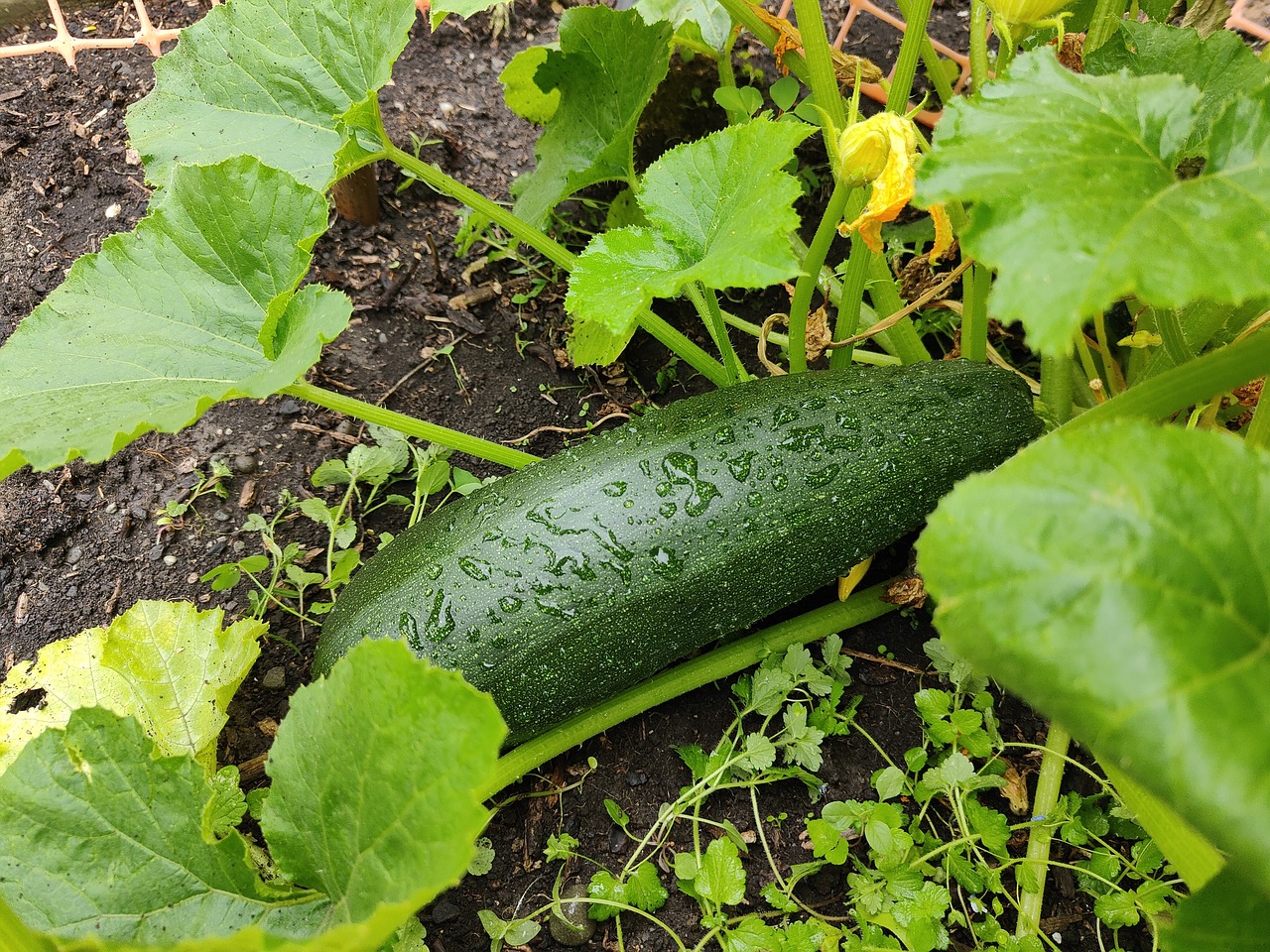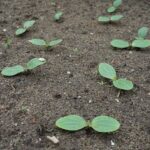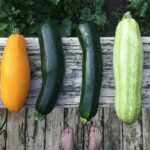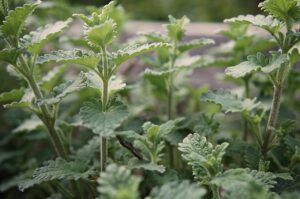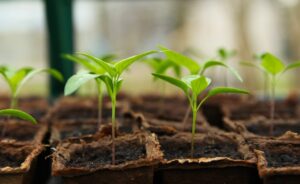Mastering Zucchini Gardening
Zucchini is a popular and versatile summer vegetable that is easy to grow and care for, making it perfect for beginner and experienced gardeners alike. In this article, we will provide you with a step-by-step guide on how to grow zucchini, including how to plant zucchini, zucchini plant care, growing zucchini vertically using a zucchini plant trellis, and exploring zucchini companion plants. We will also share tips on how to grow zucchini in pots for those with limited gardening space.
Zucchini Varieties
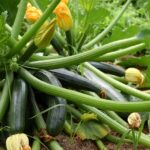
Zucchini comes in various shapes, sizes, and colours, each with its own unique taste and growth habit. In this section, we will discuss several popular zucchini varieties, starting with the dark green zucchini.
- Dark Green Zucchini: Deep green colour, classic shape, and mild flavour. Popular cultivars include ‘Black Beauty’ and ‘Cocozelle.’ Harvest time: Approximately 50-60 days, at 6-8 inches long.
- Light Green Zucchini: Light green skin, straight shape, and nuttier flavour. Examples: ‘Greyzini’ and ‘Tondo di Piacenza.’ Harvest time: Approximately 45-55 days, at 6-8 inches long.
- Yellow Zucchini: Bright yellow skin and slightly sweeter taste. Cultivars: ‘Golden Zucchini’ and ‘Gold Rush.’ Harvest time: Approximately
Yellow Zucchini 50-60 days, at 6-8 inches long.
- Round Zucchini: Unique ball-shaped fruit, perfect for stuffing. Mild flavour. Varieties: ‘Ronde de Nice’ and ‘Eight Ball.’ Harvest time: Approximately 40-50 days, at 3-4 inches in diameter.
- Striped Zucchini: Green and light green or yellow stripes, mild flavour. Examples: ‘Costata Romanesco’ and ‘Zephyr.’ Harvest time: Approximately 50-60 days, at 6-8 inches long.
Experiment with different zucchini varieties to diversify your garden and enjoy various flavours and textures in your dishes.
Purchase zucchini seeds here: Dark Green Zucchini Seeds.
How to Grow Zucchini
In this guide, we will first focus on how to grow zucchini from seed, followed by instructions on planting zucchini and transplanting seedlings into your garden.
How to Grow Zucchini from Seed
- Select the right variety: Choose a zucchini variety that best suits your taste preferences and available gardening space. Some popular options include the ‘Black Beauty,’ ‘Cocozelle,’ and ‘Golden Zucchini.’
- Start seeds indoors: Sow zucchini seeds in biodegradable seedling pots or seed trays about 4-6 weeks before the last frost date. Plant seeds about 1 inch deep and maintain a soil temperature of 70-75°F (21-24°C) for optimal germination. Zucchini seeds typically germinate within 7-14 days.
- Provide adequate light: Once the seeds have germinated, place the seedlings in a sunny windowsill or under grow lights to ensure they receive at least 6 hours of light per day.
- Water regularly: Keep the soil consistently moist but not waterlogged. Overwatering can cause the seeds to rot or seedlings to become weak and susceptible to diseases.
- Harden off seedlings: About a week before transplanting, gradually acclimate your zucchini seedlings to outdoor conditions by placing them outside for a few hours each day, gradually increasing the time spent outdoors.
Planting Zucchini & Transplanting Seedlings
- Choose the right location: Zucchini plants need at least six hours of sunlight each day. Choose a spot with well-draining soil, ideally with a pH of 6.0-7.0. If necessary, amend your soil with compost or well-rotted manure to improve its fertility and drainage.
- Time your planting: The best time to transplant zucchini seedlings is after the last frost when soil temperatures reach at least 60°F (16°C).
- Prepare the planting area: Loosen the soil in the planting area and create mounds or rows approximately 2-3 feet apart to accommodate the zucchini plants’ sprawling growth.
- Transplant seedlings: Gently remove the zucchini seedlings from their pots, taking care not to disturb the roots. Place each seedling in a prepared planting hole or mound, burying it up to the first set of true leaves. Space seedlings 2-3 feet apart to allow for adequate air circulation and growth.
- Water thoroughly: Water the transplanted seedlings well to help them establish in their new environment. Maintain consistent soil moisture throughout the growing season, providing about 1-2 inches of water per week.
By following these steps on how to grow zucchini from seed and transplanting seedlings, you’ll be on your way to enjoying a bountiful harvest of fresh, delicious zucchini all summer long.
Zucchini Plant Care
- Watering: Zucchini plants need consistent moisture, especially during the fruiting stage. Provide about 1-2 inches of water per week, either through rainfall or supplemental watering. Avoid wetting the leaves to minimize the risk of fungal diseases.
- Fertilizing: Feed your zucchini plants with a balanced, all-purpose fertilizer every 4-6 weeks, following the manufacturer’s instructions. You can also side-dress the plants with compost or well-rotted manure for a slow-release nutrient boost.
- Mulching: Apply a 2-3 inch layer of organic mulch around the base of your zucchini plants to help conserve moisture, regulate soil temperature, and suppress weed growth.
- Pest and disease control: Regularly inspect your zucchini plants for signs of pests and diseases. Handpick pests like squash bugs and apply insecticidal soap or neem oil for aphids and mites. Practice crop rotation and remove plant debris to prevent the buildup of diseases in your garden.
Growing Zucchini Vertically: Zucchini Plant Trellis
To save space and promote healthier plants, consider growing zucchini vertically using a zucchini plant trellis. Vertical growth reduces the risk of diseases caused by poor air circulation and keeps the fruits off the ground, minimizing the chances of rotting. To grow zucchini vertically:
- Install a sturdy trellis, cage, or netting near your zucchini plants when they are still young.
- Train the vines to grow up the support structure by gently weaving them through the trellis or tying them with soft twine.
- Monitor your plants regularly, guiding new growth up the trellis and removing any side shoots that may grow horizontally.
- As the zucchini fruits begin to develop, provide additional support by tying them to the trellis using soft cloth or mesh slings. This will prevent the fruits from weighing down the vines and causing them to break.
When to Harvest Zucchini
Knowing when to harvest zucchini is crucial for enjoying the best flavour and texture. Zucchini can be harvested at various stages of growth, but there are some general guidelines to follow for optimal results.
- Size: Most zucchini varieties are best harvested when they are 6-8 inches long and 1.5-2 inches in diameter. At this stage, the skin is tender, and the seeds are small and soft. Round zucchini varieties should be picked when they are about 3-4 inches in diameter.
- Timing: Zucchini typically reaches its ideal harvesting size about 40-60 days after planting, depending on the variety. It’s important to check your zucchini plants frequently, as they can grow rapidly and become oversized within a short period.
- Appearance: Harvest zucchini when the skin is glossy and firm to the touch. Avoid picking zucchini with dull, wrinkled, or hard skin, as these may be overripe and have a tougher texture.
- Frequency: Harvest zucchini regularly to encourage continuous production throughout the season. If you leave overripe zucchini on the plant, it can slow down the growth of new fruits.
By following these guidelines on when to harvest zucchini, you’ll be able to enjoy the best flavour, texture, and quality from your homegrown zucchini plants.
Zucchini Companion Plants
Companion planting can help improve the overall health and productivity of your zucchini plants. Some effective zucchini companion plants include:
- Nasturtiums: These flowers repel aphids, squash bugs, and beetles while also attracting beneficial pollinators.
- Marigolds: Marigolds deter pests like nematodes and can improve soil health.
- Peas and beans: Legumes fix nitrogen in the soil, providing a natural fertilizer for your zucchini plants.
- Radishes: Radishes deter squash vine borers and can be harvested before the zucchini plants need the space.
- Borage: Borage attracts bees and other pollinators, improving the fruit set of your zucchini plants.
Avoid planting zucchini near potatoes, as they can compete for nutrients and attract similar pests.
Seeds can be purchased here: Flower Seeds, Herb Seeds, Fruit Seeds, and Vegetable Seeds.
Zucchini How to Grow in Pots
Growing zucchini in pots is a great option for gardeners with limited space. To successfully grow zucchini in containers, follow these steps:
- Choose a compact variety: Opt for a bush-type zucchini variety, such as ‘Patio Star,’ ‘Ronde de Nice,’ or ‘Eight Ball,’ which are better suited for container growing.
- Select a large container: Use a pot with a minimum capacity of 5 gallons and drainage holes at the bottom. A larger container will provide adequate space for the roots and help retain moisture.
- Use high-quality potting mix: Fill your container with a well-draining, nutrient-rich potting mix. Avoid using garden soil, as it can become compacted and limit root growth.
- Plant one zucchini per pot: Sow seeds or transplant seedlings into the center of the pot, following the same guidelines as for planting in the ground.
- Water and fertilize: Zucchini plants in pots may require more frequent watering, as containers dry out faster than garden beds. Monitor the soil moisture and water as needed. Feed your plants with a balanced, water-soluble fertilizer every 2-3 weeks.
- Provide support: If you choose a vining zucchini variety, install a small trellis or stake to support the plant as it grows.
Common Questions Answered
In this section, we will address some frequently asked questions about growing zucchini.
What is Summer Squash?
Summer squash refers to squash varieties harvested during summer when the fruit is immature and the rind is tender. Examples include zucchini, yellow squash, crookneck squash, and pattypan squash.
Is Zucchini Squash?
Yes, zucchini is a type of summer squash belonging to the species Cucurbita pepo. It is also known as courgette in some regions.
How Much Sun Does Zucchini Need?
Zucchini plants need at least six hours of direct sunlight daily for optimal growth and fruit production. Choose a sunny location with well-draining soil for best results.
Conclusion
Learning how to grow zucchini can be a rewarding and delicious experience for gardeners of all skill levels. From how to plant zucchini and choosing the right location, to growing zucchini vertically with a zucchini plant trellis or in pots, there are numerous ways to cultivate these versatile summer squashes. With proper zucchini plant care, including watering, fertilizing, and selecting the right zucchini companion plants, you’ll be able to enjoy a bountiful harvest of fresh, flavorful zucchini all summer long. Remember, whether you’re growing zucchini in a spacious garden or exploring how to grow zucchini in pots, the key is to provide ample sunlight, well-draining soil, and consistent care.

